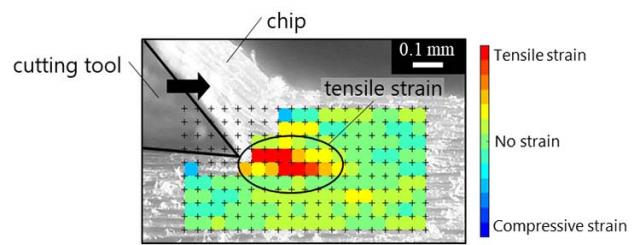Home > Research > Research Results > Research Results 2018 > Visualizing deformation (strain) in wooden materials during cutting
Update:September 26, 2018
Main content starts here.
Visualizing deformation (strain) in wooden materials during cutting
| Article title |
Strain analysis near the cutting edge in orthogonal cutting of hinoki (Chamaecyparis obtusa) using a digital image correlation method |
|---|---|
| Author (affiliation) |
Yosuke Matsuda (a), Yuko Fujiwara (b), Yoshihisa Fujii (b) (a) Department of Wood Properties and Processing, FFPRI, Tsukuba, Ibaraki, Japan. |
| Publication Journal |
Journal of Wood Science, 53(2), 2018, DOI:10.1007/s10086-018-1724-x( External link ) |
| Content introduction |
The surfaces of wooden products can be smoothly finished using machining methods such as planing. However, depending on the state of the cutting tool and the characteristics of the wood, excessive deformation (strain) can occur during cutting, which can cause machining defects such as fuzzy grain. This means that excessive strain should be avoided while cutting, but the kind of strain distribution that occurs while cutting has not been sufficiently analyzed. Therefore, to analyze this, we recorded woodcutting using a high-speed camera, and by analyzing the acquired digital images using a digital image correlation method (note), we successfully visualized the strain distribution around the cutting edge, as shown in Figure 1. We confirmed that the size and range of the strain around the cutting edge change characteristically according to depth of cut and cutting angle. This suggests that the occurrence of strain can be controlled by adjusting the cutting conditions, thus reducing the occurrence of defects on the processing surface. The analysis method used in this study can be applied to cutting tool design and optimizing cutting conditions. (Note) Digital image correlation method: A method where the strain in a test subject is calculated by comparing images of the test subject taken before and after deformation.
|
Copyright © Forest Research and Management Organization. All rights reserved.

